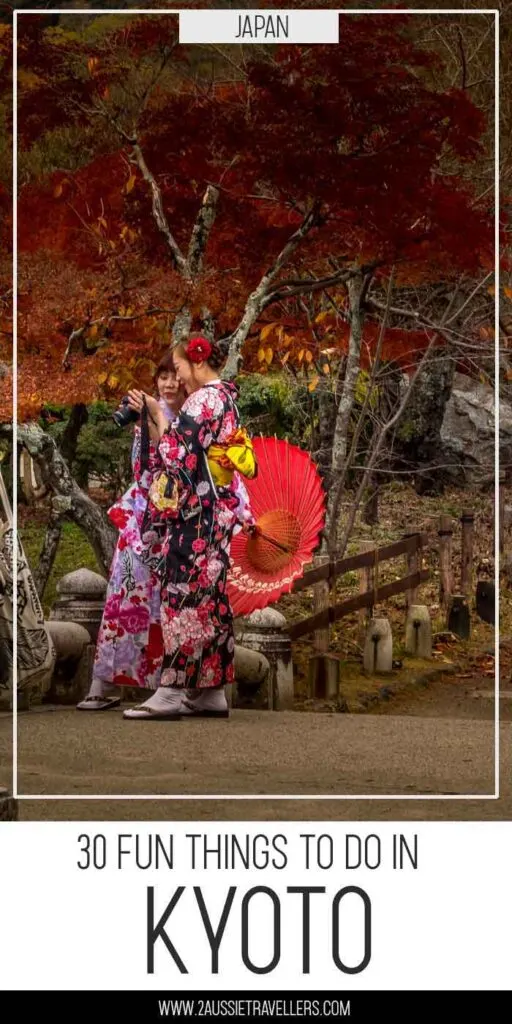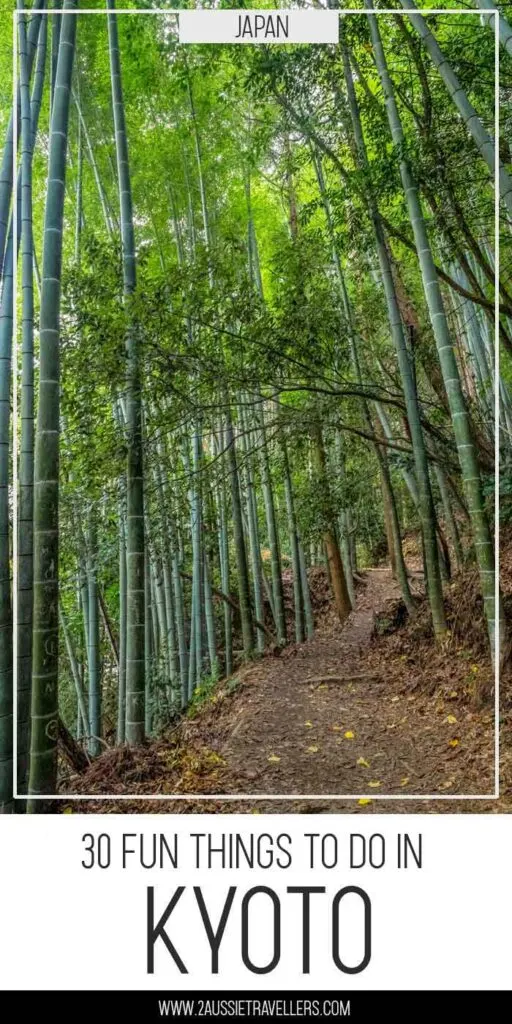In this Kyoto travel guide, we share the most popular and lesser-known things to do in Kyoto along with all our top tips about where to eat, play and stay in this historic, culturally rich and fun city.
Kyoto is one of our favourite cities to visit and one we’ve returned to repeatedly over the years. It’s steeped in history and traditional Japanese culture, these form the basis of things you must explore and experience while in the city. But that’s not all it has to offer, Kyoto is also a city for foodies, and for those who love nature, art, architecture and gardens.
To ensure you have all the information you need but still keep things easy to read, our Kyoto travel guide contains a number of links to more detailed articles, visitor guides and reviews within our site that cover many of the places and events mentioned. Please click through and continue reading for additional information as you plan your trip. If you have any questions we’d be happy to answer them. you can leave any comments or questions at the bottom of this article and we’ll get back to you.
Table of Contents
Don’t miss these temples & shrines
There are a huge number of temples and shrines in Kyoto, they are fascinating to visit and many are incredibly beautiful and photogenic. However, we are aware that some people do feel ‘templed out’ after a while in the city so that makes it even more important that you target the ones that are the most interesting to you.
In addition to a few iconic spots we cover below for first-time visitors, we have a separate post that covers the information you’ll need for visiting our top 15 Buddhist temples within the city and another that covers things you might want to know before visiting a Shinto shrine.
1. Golden Pavillion (Kinkakuji)
The Golden Pavillion of Kinkakuji is one of the most beautiful and widely recognised Buddhist temples in Japan. It’s pretty much always busy but one that really should be part of the itinerary for any first time visitors to Kyoto. We highly suggest making this one of your first stops of the day, getting there at opening time adds to the feeling of serenity as you wander through.
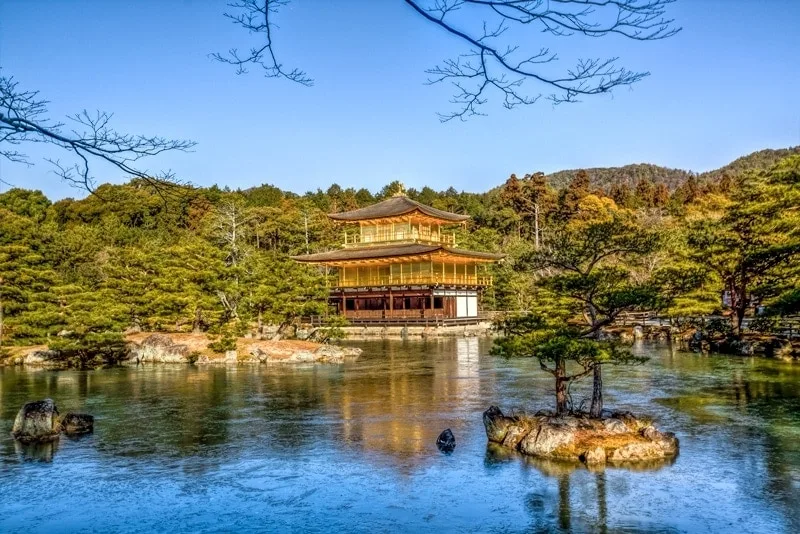
There is much more to this complex than the often photographed gold-clad pavilion, the grounds are a stunning backdrop in all seasons making it worthy of a return visit too.
- Read more about the history of Kinkakuji and planning a visit to the Golden Pavillion
2. Kiyomizudera
For the overall temple experience, especially in the spring and autumn, you can’t miss Kiyomizudera. Walking up the Sannenzaka and Ninenzaka shopping streets on the approach you first get to enjoy the feel of the old town.
Gift shops, tea rooms and delicious snacks are found all along here including the best Nikuman (meat dumpling) we’ve found in Japan and some choux pastries filled with a heavenly silky smooth custard-like filling.
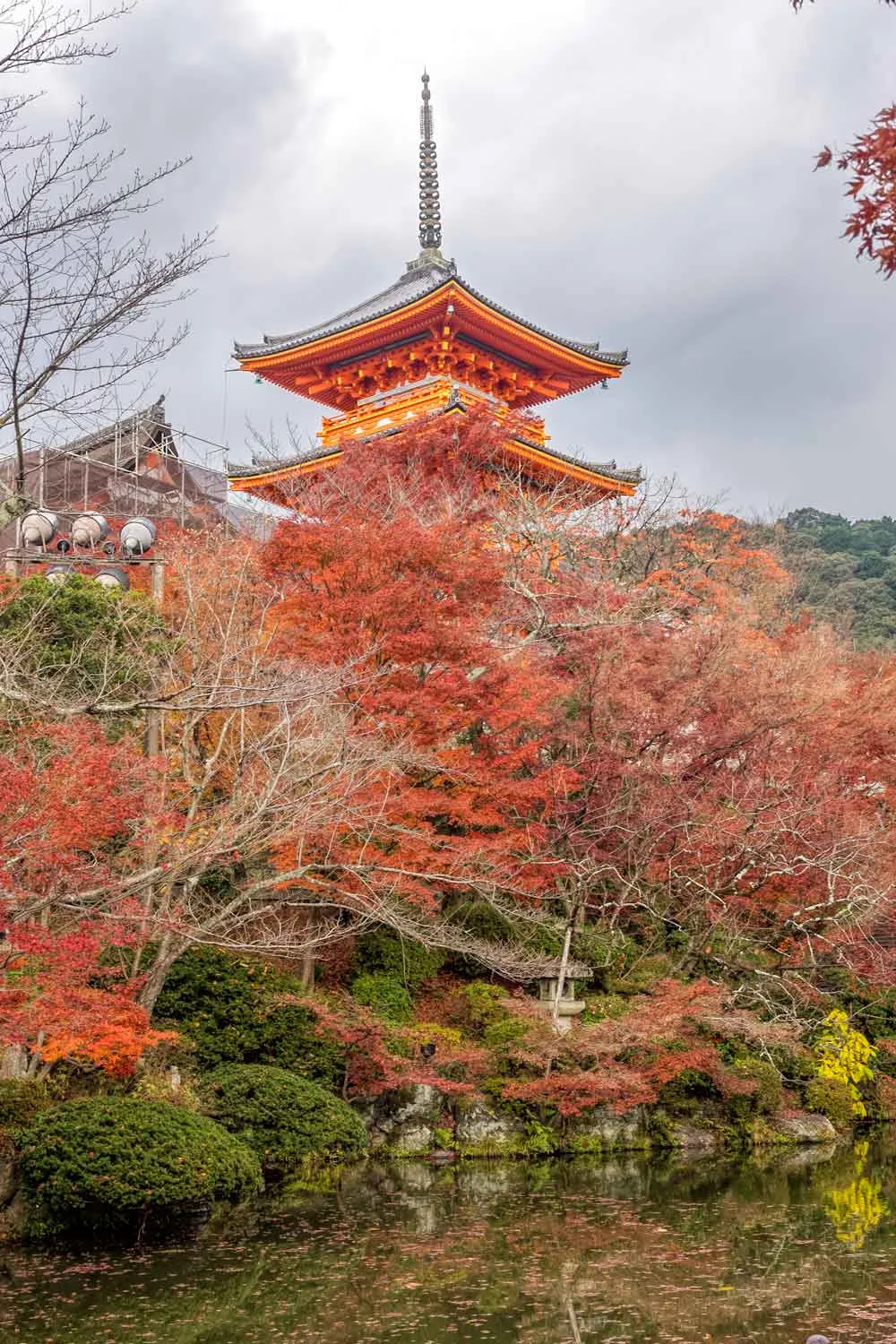
The temple itself is large and impressive with the main hall boasting a huge cantilevered deck built without a single nail. There are unique features here too like taking a drink from the Otowa Waterfall (which stream will you choose, health, wealth or happiness), the pitch dark underground hall where you must feel your way in stockinged feet and some extra special festivals for the water dragon who guards the temple.
- Read more about Kiyomizudera Temple and how to include it in your itinerary for Kyoto
3. Fushimi Inari
Fushimi Inari is our top pick of the Shinto Shrines in Kyoto. They are a unique part of Japanese culture and this one offers something special in its location. While Fushimi is now an extremely popular destination it’s worth braving the crowds and allowing time to walk up through the familiar orange tori gates to get the expansive view of Kyoto city from the top.
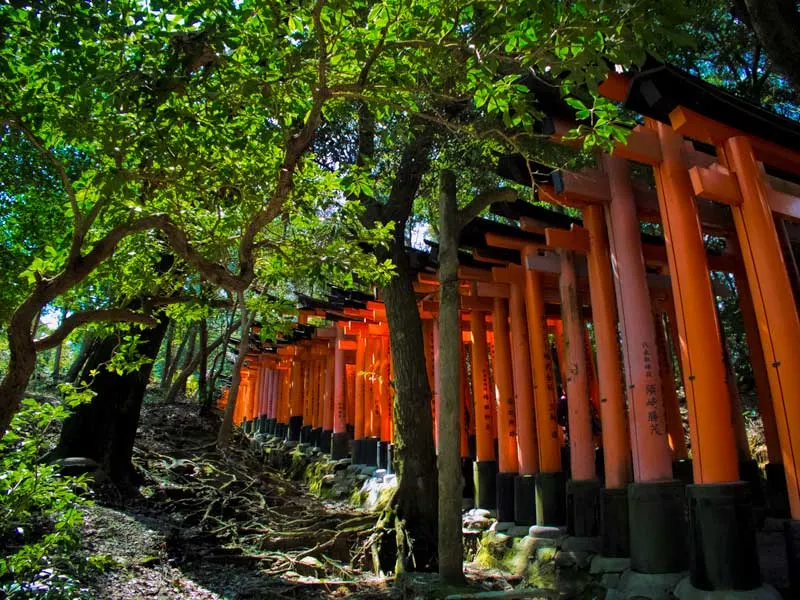
There are also many small shrines and paths that lead off to interesting discoveries along the way including a pretty bamboo grove beside the pond. During the day the main courtyard bustles with shrine activity and we’ve often seen small ceremonies, wedding parties and a local festival here.
4. Heian Shrine
The Heian Shrine was built on the 1100th anniversary of Kyoto in 1895 and was dedicated to the first and last emperors of Japan who ruled from the city. Heian was the name for Kyoto during that period.
The main shrine building is a small scale replica of part of the Imperial Palace from that time. It is surrounded by a large open courtyard that hosts a variety of events throughout the year.
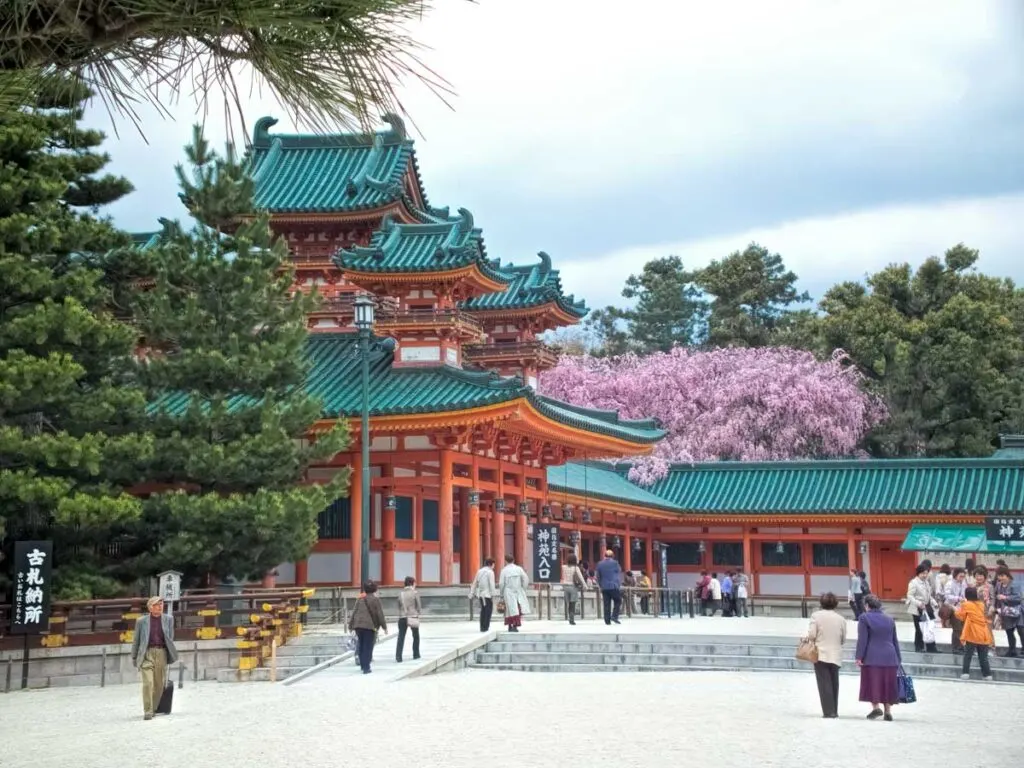
The shrine grounds are free to enter but there is a beautiful garden behind that charges a small entrance fee. It is known as one of the best viewing spots for weeping cherry blossom in Japan and is at its peak towards the end of the blossom season.
The shrine is located not far from Nanzenji and Eikando temple or a 10-minute walk from the Higashiyama subway station.
Where to explore in suburban Kyoto
These spots are nearby, easy enough to get to and part of Kyoto city but they are a slight detour into the suburbs so transport options may be slightly less frequent but the crowds will also generally be a little less.
5. Arashiyama
Arashiyama is a suburb of Kyoto and has been a popular sightseeing spot and escape from the city for centuries. Today it’s only around 20-minutes on the JR Sango line from Kyoto station but unless you are there in the height of cherry blossom or autumn leaves it has a very different feel to the city.
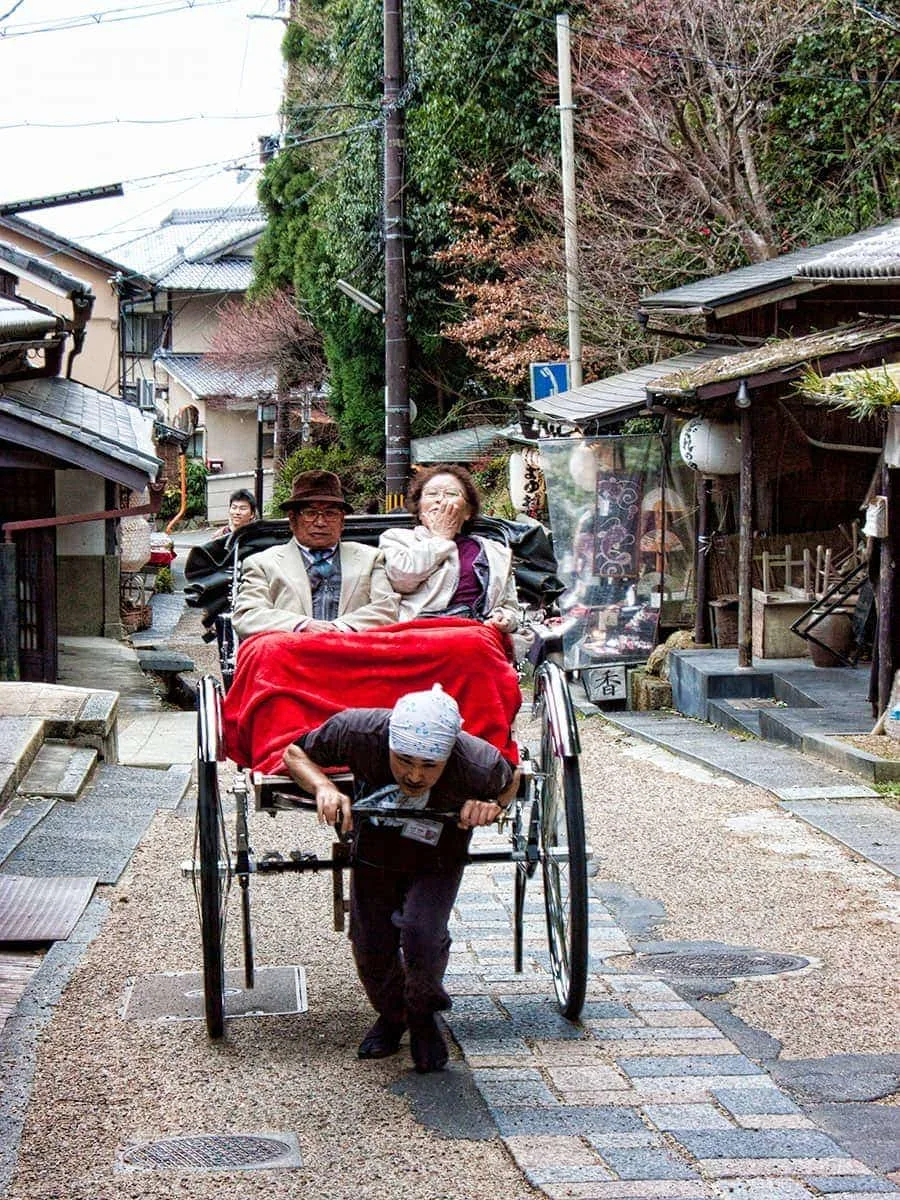
Key attractions here are the Tenryu-ji zen temple and the bamboo groves but there are many small temples with beautiful gardens to visit. There are great restaurants, take a walk along the river, visit the monkey forest or relax in an onsen.
Read more: Our top things to do in Arashiyama, Kyoto
6. Bamboo Groves
The most famous of the bamboo groves around Kyoto is in Arashiyama, you can’t miss them on social media and that particularly photographed walk is behind the Tenryuji temple. It’s only a short walkway but if you wander along the river and up to the less well-known temples in the Arashiyama hills there are move groves, some along the roads, others tucked away behind temples.
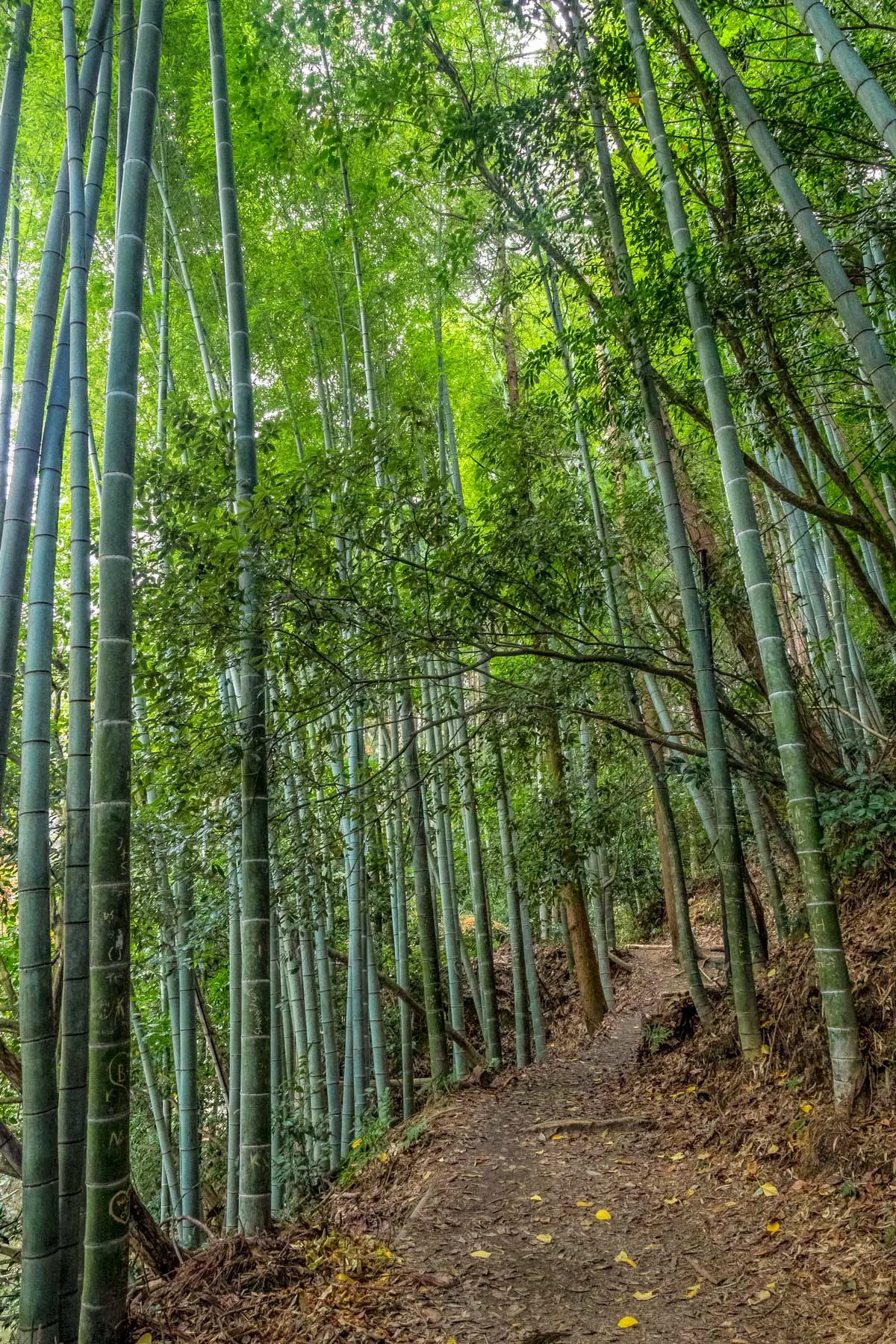
Another grove I particularly like is found on one of the less followed tracks at Fushimi Inari. As you head up the hill you take a branch to the right rather than the more obvious left turn and follow a natural path with bamboo towering overhead and a small lake out to the side.
7. Sagano Scenic Train
Sagano is a scenic and peaceful area in Kyoto, it is known for its rural landscapes, seasonal colour, bamboo groves and natural beauty. One really easy and memorable way to experience the area is to take the 7km Sagano scenic train from Arashiyama to Kameoka. It’s a tourist, not a commuter train so you need to prebook your tickets as a tour.
Each train has several carriages with large opening windows and one fully open carriage. If you are dressed for it I would take the open-air option to be really immersed in the scenery.
8. River Boat ride
Hozugawa River Cruises run traditional style flat bottom river boats from Arashiyama to Kameoka and are a great option to pair with the Sagano scenic train doing the trip one way by boat and the other by train.
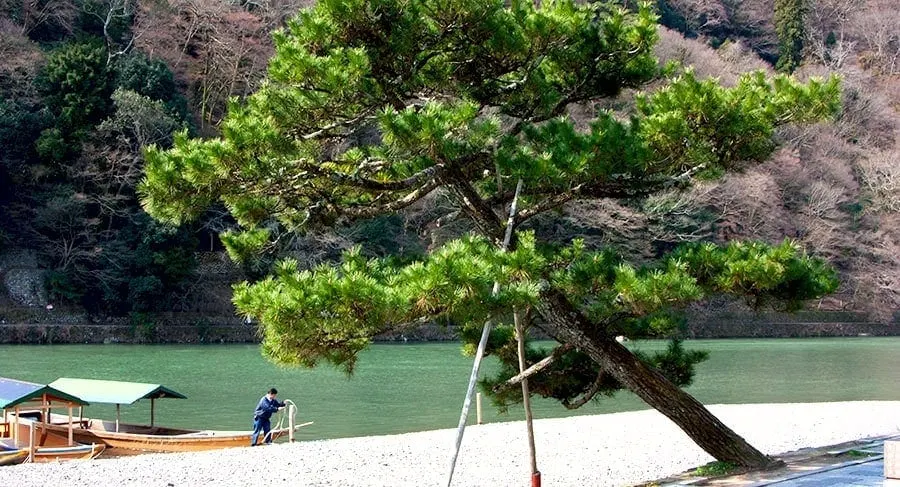
Along the way, you’ll enjoy the natural scenery through the ravine from the Hozugawa River. The boats are a relaxed way to travel powered by skilled oarsmen rather than motors it can be quite peaceful. Many of the boat captains are quite the comedian judging by the laughs on board but while instructions and safety information are clear much of the commentary is lost in the language gap if you aren’t fluent in Japanese.
9. Daigoji
Daigoji is a Buddhist temple and World heritage site south of Kyoto city in Fushimi ward. The temple itself is interesting having been established on this site in 1599 but the main temple building itself dates back to 926. The 5-story pagoda dates to 956 and is Kyoto’s oldest verified building.
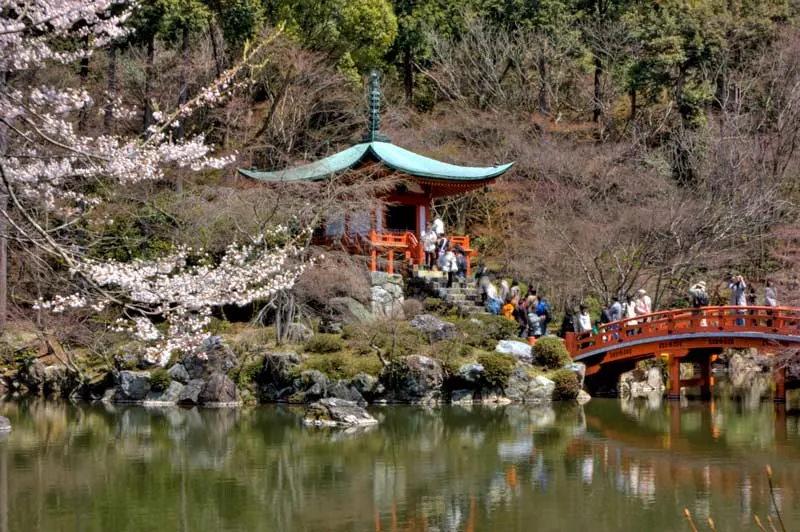
The gardens are well-tended and at their best in autumn or during the blossoms. The treasure hall contains many documents and artifacts but is probably of more interest to those who read Japanese. One of the things that I like about this one is that it is situated at the base of a hill which is part of the temple and you can follow the rustic walking trail up kami-Daigo discovering a spiritual well and the upper temple buildings. While the lower temple can be quite busy, especially if you visit on a festival day, the hillside feels like a very different place.
Daigoji has a long connection with Japan’s imperial family and its feudal history. During April there is a festival here called Ho-Taiko Hanami Gyoretsu or Toyotomi Hideyoshi’s cherry blossom-viewing parade. Hideyoshi is celebrated as one of Japan’s 3 great unifiers and the festival recreates his grand sakura party from 1598.
Read more about Daigoji temple and plan your visit here
10. Fushimi Sake District
We mention the Fushimi Inari shrine above as a great Kyoto experience, Daigoji above is also in the wider Fushimi ward of Kyoto and another area to explore south of the city centre is the Fushimi sake district.
The heritage sake district is home to almost 40 breweries along the Horikawa River. The traditional wood and white buildings house some open sake breweries where you can do tastings and make purchases, a museum, an informative visitors centre and river boat tours that run up and down the river in flat bottom wooden boats that once transported sake and supplies.
You can plan a visit here independently taking the train to Chushojima station on the Keihan line, about 15 minutes from Kyoto station, or alternatively experience the area with a local guide who can explain the sake process and history of the region in more detail, organise tastings and lunch.
11. Uji
A day trip to Uji is one of our highly recommend things to do in Kyoto. The area is known for its green tea, some of the highest quality in Japan and you’ll have the opportunity to try and buy it in many forms around Uji. From tea tasting to tea ceremonies, green tea noodles, cakes and ice creams there is an appealing way for everyone to give this local product a try.
Located on a picturesque river with a green backdrop it’s a lovely town to wander around. Discover the famous Byodo-in temple which you might recognise from the Y10 coin, the Hoshokan Museum of temple treasures, stroll the heritage-style shopping street and narrow islands in the centre of the river, visit local shrines and discover historic springs.
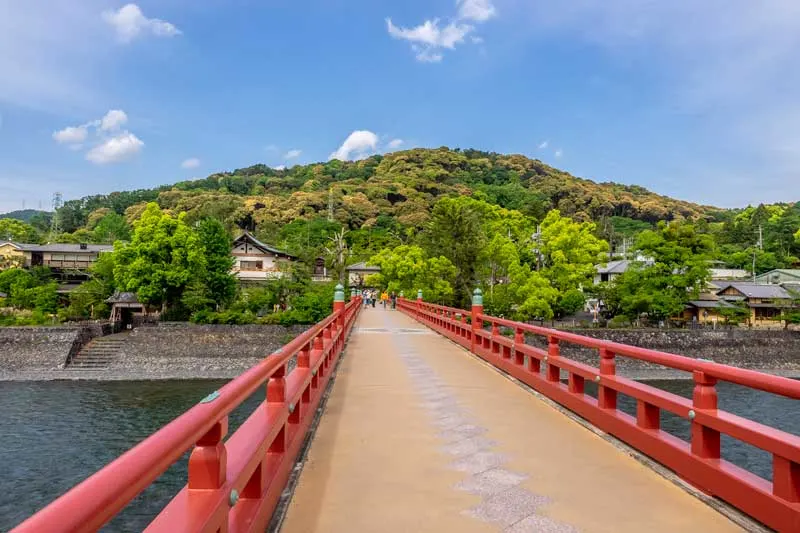
The link above has all the information you need to plan your own independent trip to Uji or you can join a guided tour such as this one run by Arigato Japan, a company that we’ve done tours with several times. They will introduce you to the area and its history, you’ll learn all about matcha, join a tea ceremony experience and enjoy a delicious lunch.
The top foodie highlights
Osaka might be known as the foodie capital of Japan but Kyoto can more than hold its own.
12. Nishiki Market
Exploring Kyoto’s food scene without a visit to Nishiki market really isn’t possible. The thing to remember here is to start a little later in the day, if you are used to being in early at the farmers’ markets at home or the pre-dawn start at Tokyo’s fish market that is not the case here, things don’t really get going before 10 but activity continues into the late afternoon with some stores remaining open in the evening.
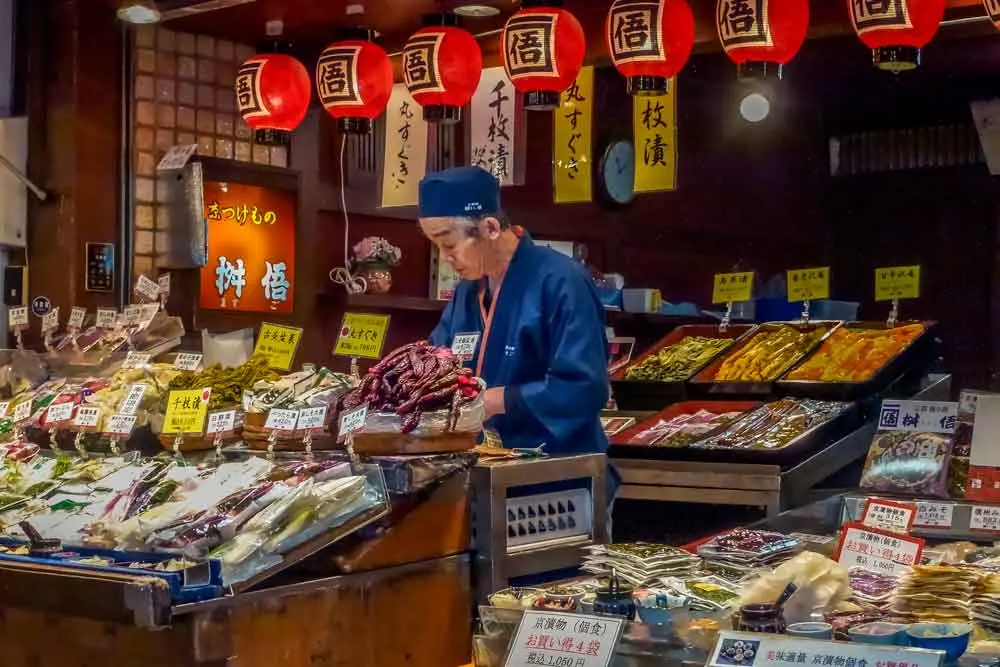
As with any market, it’s well worth going hungry and with your sense of adventure intact, you are almost certainly going to come across something that is new to you. A few personal favourites are the yuba, a thin layered tofu skin, mugwort mochi cooked over a charcoal grill, black soybean tea various Nukazuke pickles which make a healthy and delicious snack and the Takoyaki stall although I find it hard to resist it cooked fresh in most places.
13. Lets go ‘Kafé-meguri’
A Japanese phrase I came across relatively recently is kafé-meguri (カフェ巡り) cafe hopping. This doesn’t generally mean heading to Starbucks and Doutor, it usually involves independent cafes with a unique style, kawaii decor or quirky vibe.
Next time I’m in Kyoto for a good amount of time I might have to do my own kafé-meguri research with some of our favourite spots but in the meantime here’s a few you might want to try.
A term you might hear alongside ‘cafe’ in Japan is Kissaten. A Kissaten is, literally translated, a tea-drinking shop but it’s perhaps more frequent to drink coffee than tea. While there are some legal differences between a café and a kissaten, for example in the licences they normally operate under, the main difference you notice as a customer is a different feel.
Very few new kissaten open up so many of them are older, family operated businesses. They often have a heritage feel with the Showa era booth styling and cater to a mainly older clientele while cafes are often modern with an international feel and attract a younger following.
A kissaten is more a place to relax, a place for conversation, you don’t tend to stop by and grab a coffee you stay a while and have a coffee, a tea and maybe some food. They will often have manga, magazines and newspapers to browse. Why not try one and decide what your own preference is, cafe or kissaten?
14. Daimaru Basement food floor
Department stores across Japan tend to have the basement floor as a food floor, not a food hall, restaurants are usually upstairs but there are all sorts of foods to browse and buy. In Kyoto, the big one you don’t want to miss is Daimaru on Shijo-Dori, just down from the Nishiki Market.
Some of the food you’ll feel is very overpriced, you might spot a boxed melon or strawberries at a mind-boggling price, over US$100 for a cantaloupe, gulp. These are specialty gift items for the local market, they are grown with love and care and they are perfect, they aren’t something you chop up on your breakfast cereal.
I really love to browse these food floors, but I’ll also pick up some really good tea or packaged condiment to take home, my choice of souvenir is almost always consumable but there are ready-to-eat items that are good here too if you want a picnic to take out with you or a light meal to take back to your accommodation.
The price is a bit higher than picking up something at 7-eleven but then the choices and quality are a step up too. We make frequent use of the bakery, there are often some good sushi platter deals especially later in the day and their fabulous French-style cake selection has become a guilty treat. Their individual cakes are so beautiful and perfect with a mirror glaze and detail but perfectly sized and not too rich.
Just for clarity, we have nothing against 7-eleven and other convenience store food options in Japan, we have bought and eaten from them many times including raw fish with no problems at all and they have great variety too.
15. Starbucks Kyoto style
Not everyone loves Starbucks it’s true but many young Japanese have fully embraced them. If you want to try one out in Japan there are 3 in Kyoto that we enjoy for the way that they meld the uniformity of Starbucks with the unique feel of being in Japan. It’s a unique experience you wouldn’t expect.
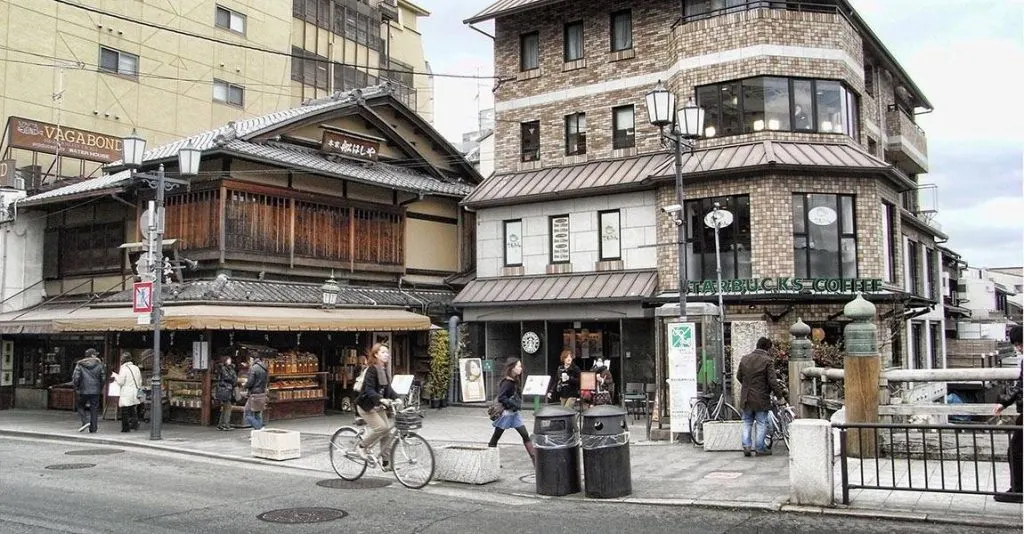
- Starbucks Ninenzaka Yasaka Chaya is set in the streets of Gion looking much like the other traditional wooden homes and businesses from the outside. Even the classic green sign has been given a classy wooden upgrade.
- The second is Starbucks Sanjo-Ohashi on the edge of the Kamo River where you can grab a window bench seat looking out.
- Starbucks Karasuama-Rokkaku is located adjacent to Rokkaku-do temple where you can sip your chosen concoction in the comfy padded chairs in front of the huge glass panes with a view of the temple garden beyond. Rokkaku-do makes our list of 15 top temples to visit in Kyoto and has a long and interesting association with the art of ikebana.
16. Join a food tour to understand the Kyoto cuisine
We almost always travel independently but will join a day or short tour when I feel it will really add to the overall experience. Food in Japan has frequently been one of those exceptions as there is so much culture, regional specialisation and history interconnected with it. Not to mention that many great experiences really aren’t set up to cater to foreigners who don’t speak Japanese.
We did an evening food tour in Gion with Magical Trip which was an absolute game-changer for me. Our guide was a Japanese university student with perfect English and one of those people who can relate to everyone. The places we went to represented an excellent cross-section of food styles and he imparted so much knowledge for the rest of our trip and future trips.
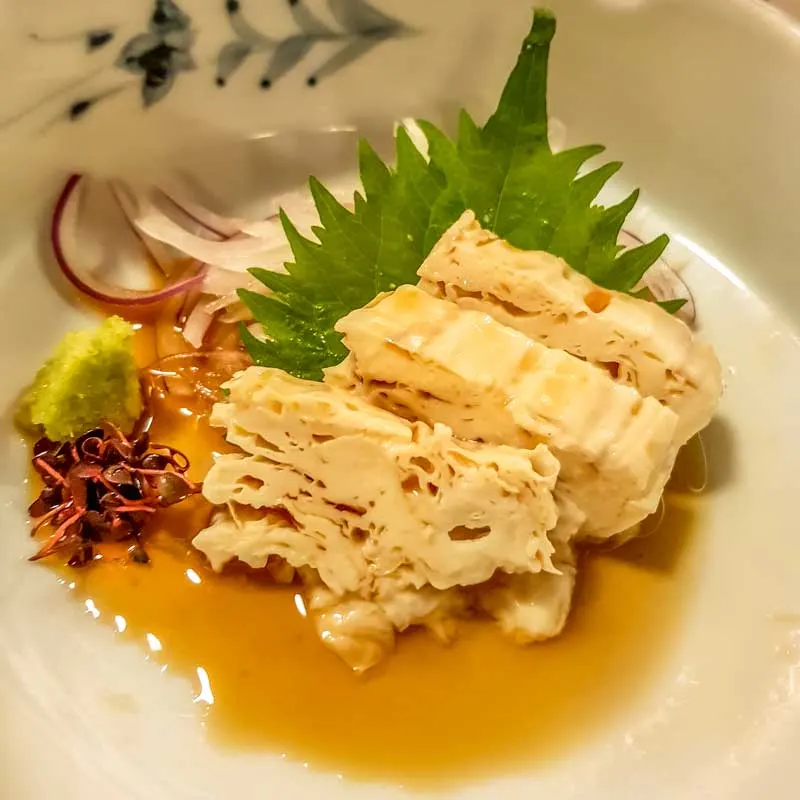
It was a small group and one of the guys had an interest in Japanese whisky, our guide had plenty of info to share and pointed out places to try later. I don’t like strong-tasting alcohol so don’t usually try sake but Taka introduced me to a sparking sake that I happily sought out for the rest of my trip although I suspect it’s more often a favourite of teenage girls.
You might want to read this one for more information on our Gion food tour and some local foodie tips or find current booking information here.
17. Enjoy soba and other food Kyoto is known for
Each region of Japan is known for its specialty foods and food styles and Kyoto is no exception. We have an article that covers many of the delicious and unique dishes the prefecture is known for but soba is one of our favourites.
Depending on the season it is served in different ways. In winter a steaming bowl of broth laden with meats, vegetables and the hearty goodness of the buckwheat noodles but in summer the soba is cold and served with a bowl of dipping sauce and small dishes of condiments and sides.
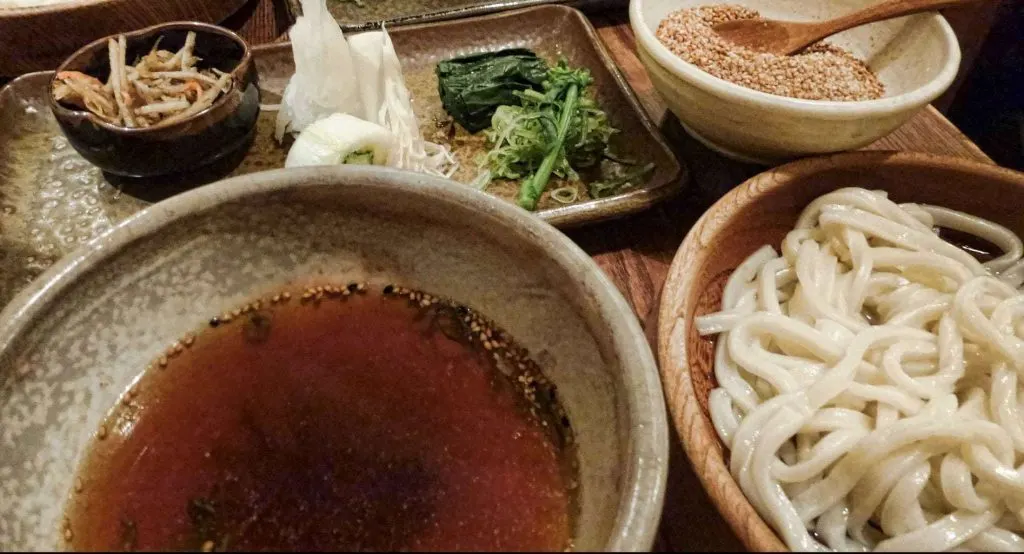
A great place to try the various forms of soba as part of a season menu is at Omen, there is one in Pontocho on Shijo Dori (street) just over the Kamo River from the Shijo-Gion station and another very close to the Ginkakuji, the silver pavilion.
18. Tea ceremony
Many of the Japanese cultural arts evolved in Kyoto and the tea ceremony is one of them. The ritual of tea preparation and serving came to Japan through Zen Buddhism and has a strong connection to some of the temples in Kyoto such as Ginkakuji, the silver pavilion.
The ceremony represents harmony, respect, purity and tranquillity and I particularly enjoy a ceremony that shares information about the significance of the different aspects of the ceremony and where the tea is from. Two that are particularly good for this are this one is by a Urasenke tea master near the Golden Pavillion and this tea ceremony at Jotokuji temple.
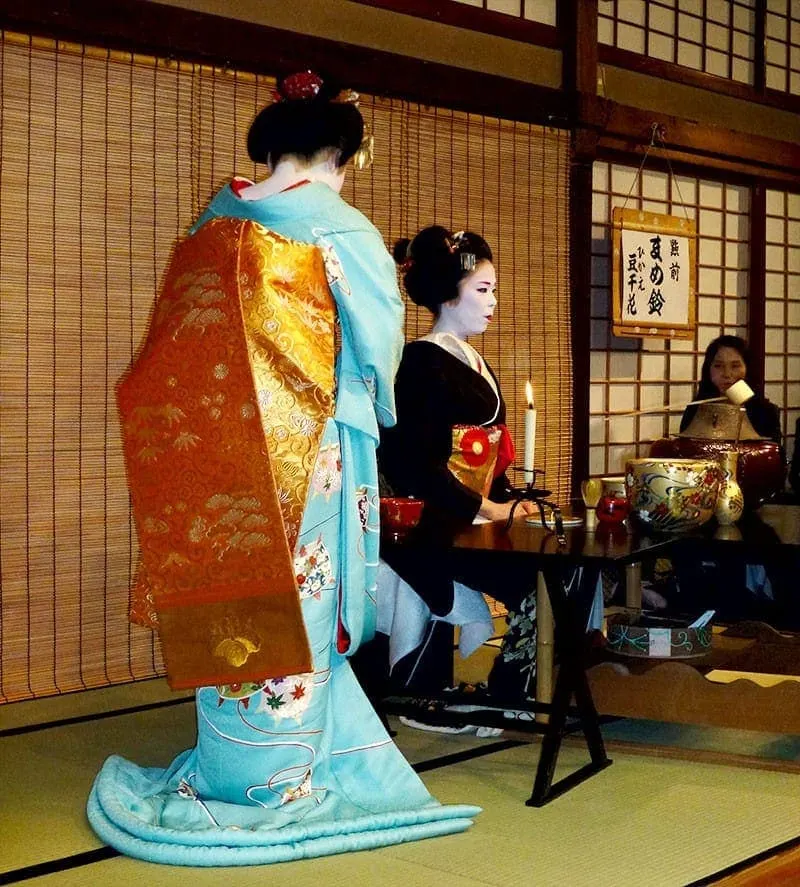
A different tea ceremony experience is the one performed by Geisha who are known as Maiko and Geiko in Kyoto. There are some tour experiences that focus specifically on this and other options that are part of events like enjoying tea and a traditional sweet before the Gion spring dance performance or at a plum blossom festival in Kitano Tenmangu Shrine.
Learn more about the Japanese Tea ceremony in this article and the different types of Japanese tea in this one.
Essential history and cultural sites
19. Imperial Palace
Central to the city’s culture and history is the Imperial Palace dating back to when the city was the capital of Japan. If you only have the opportunity to visit one I’d prioritise Kyoto over the Tokyo Imperial Palace. You used to have to prebook your tour or attend during a special opening day which could be very crowded but it now has regular opening hours. Entry is free and there are still guided tours in English if you want to join one.
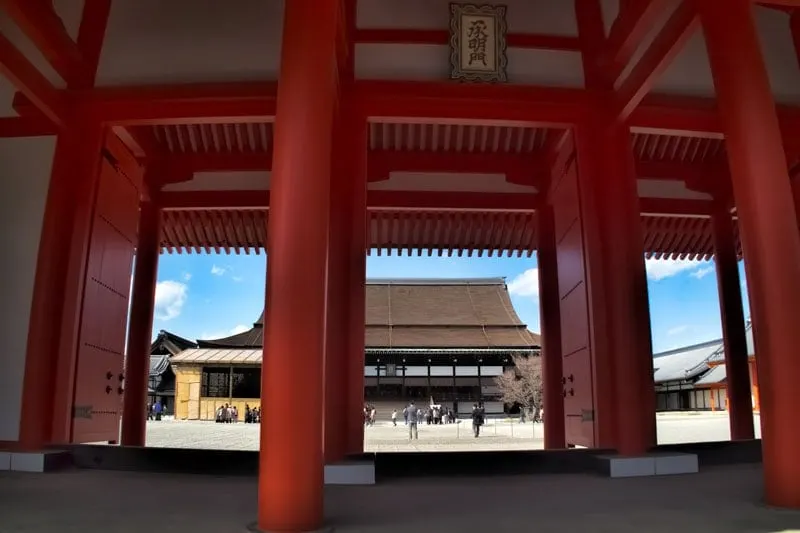
It was the home of the Imperial Family until 1868 when the capital moved to Tokyo. The buildings are built in the traditional style on an impressive scale and the gardens are beautiful. If you are interested in the architecture there is a display that demonstrates how the roof is thatched and you have the opportunity to see some of the beautiful hand-painted screens up close. The park is large and on the grounds to the north of the palace is one of the city’s top spots for late-flowering cherry blossom trees.
20. Nijo Castle
Nijo Castle is sometimes overlooked by visitors because only the ruins of the castle tower remain but the expanse and completeness of the gardens, fortification structures and importance of the other buildings do make it worth considering for your itinerary. Nijo Castle is a World Heritage site for good reason.
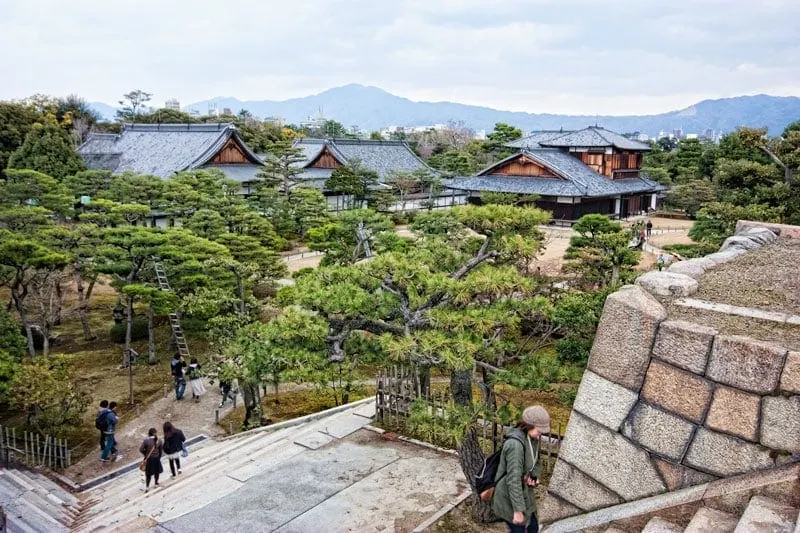
Read more: Planning your visit to Nijo Castle, Kyoto
21. Geisha
Kyoto is a city that still embraces and celebrates its national culture. It’s one of the few cities where Geisha still operate much as they have in centuries gone by, although in much smaller numbers. There are 5 hanamachi (geisha districts) in Kyoto and 4 of these are in close proximity to each other.
If you plan your evening walk through these areas on the way to and from dinner you have a chance of spotting a geisha (geiko or maiko as they are called in Kyoto) out and about on their way to their evening engagements.
Another option is to attend a show, local festival or dinner function where geisha will be entertaining. For more information on geisha culture in Kyoto read:
- Exploring the geisha districts of Kyoto
- The Miyako Odori spring dance and tea ceremony
- Exploring the geisha districts of Kyoto
22. Kimono parade
It is not unusual to see Japan’s traditional dress, the kimono, still worn in everyday life today. Elaborate versions are worn for Shinto wedding ceremonies and the more simple yakata is often worn by young women to festivals and seasonal celebrations. Others wear it as part of their work uniform, either in the tourism industry or in high-end restaurants.
You will see groups of immaculate middle-aged women wear it when they meet for lunch, for special events and celebrations, or occasionally couples strolling through the older parts of town in traditional dress. It really is an elegant national dress and one that allows for so much individual expression.
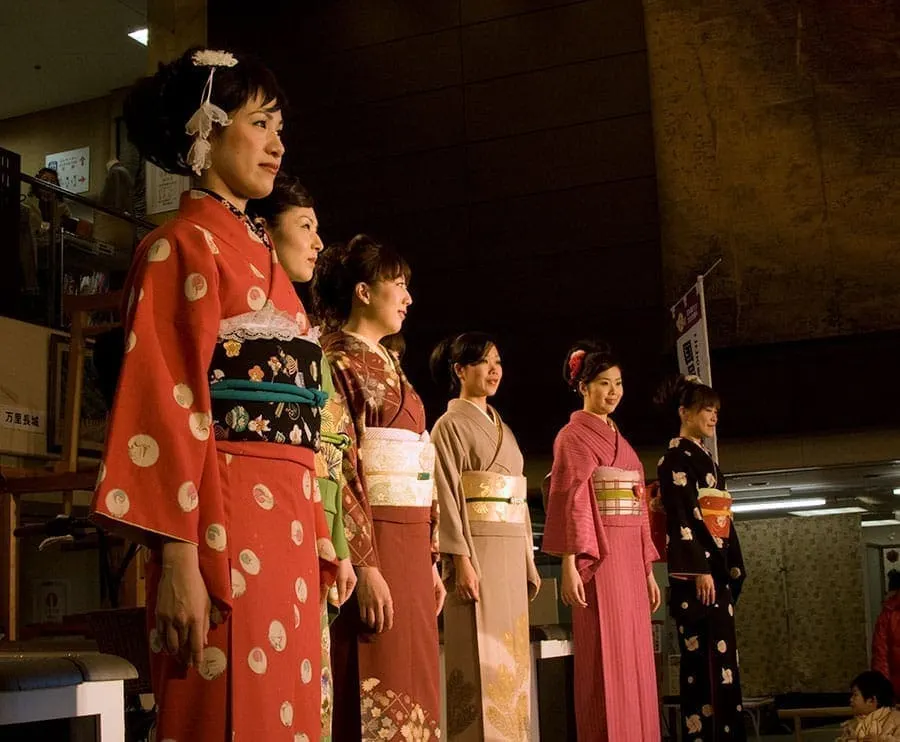
The Nishijin textile centre is an opportunity to see kimonos styled and worn in a kimono fashion parade several times a day. At the centre, you also have the opportunity to see a display of silkworms that produce luxurious fabric and weaving demonstrations that show how some of the more elaborate fabrics and wall hangings are created.
The Nishijin Textile Centre is about 1 km from the Imperial Palace and 1.5 km from Nijo Castle. If you are heading out to the show you might be interested in our central Kyoto walking tour post for ideas of other nearby attractions to combine into your visit.
23. Explore the gardens
Kyoto has some historic and beautiful gardens, traditional Japanese garden design is a true art and you can see it in practice in many places around the city. In Kyoto many of these are associated with various temples, a few I’d recommend taking a look at are:
- Ginkakuji temple with its sculpted dry sand gardens and strolling gardens winding up the hill behind to uncover views back to the central city.
- Eikando temple for its seasonal display particularly during the autumn leaves and vistas down towards the pond or beyond to the hills.
- Ryoanji temple for its walled zen garden but also its large pond and stroll garden borrowing the scenery of the extensive hillside behind.
- Gio-Ji for its moss garden in Arashiyama, so serene and presumably a labour of love and dedication to keep it weed free
- Okochi-Sanso Villa also in Arashiyama for its lovely stroll garden with a bowl of matcha and sweets included in the entrance fee
24. Philosophers’ path
The Philosophers Path is arguably Kyoto’s top cherry blossom spot, it is truly beautiful in that season but that doesn’t mean it should be overlooked at other times of the year. The path follows the Lake Biwa canal from Ginkaku-Ji temple (the silver pavilion) south to Nanzen-Ji.
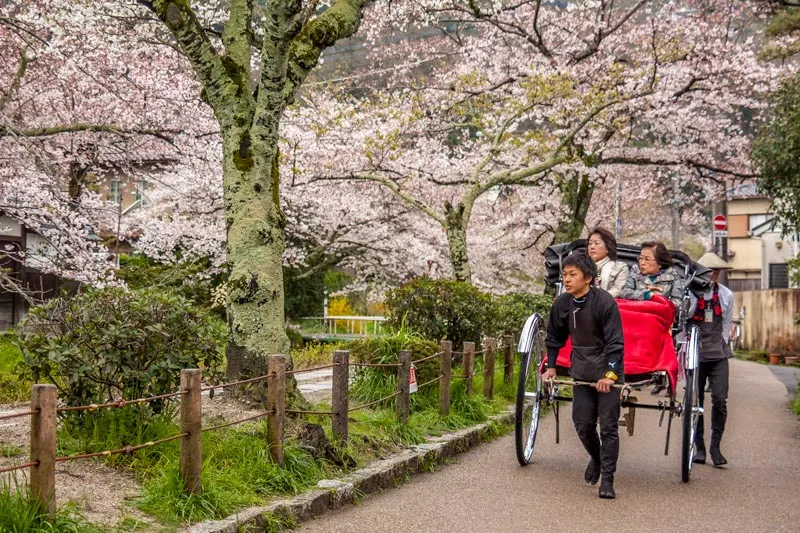
When the blossoms aren’t at their peak it is a calm walk under the dappled shade of large trees. Along the way, you will be tempted into cafes, small craft shops and lesser-known temples and gardens. Do stop in at Honen-in and Eikan-do and let yourself browse some of the artisan galleries along the way.
25. Experience a local festival
If there is a local festival or event when you are in town it can be a fantastic opportunity to mix with the community and experience some of the culture and hospitality of the city. We particularly enjoy the smaller events but there is a whole range to choose from. Some to consider are:
- Setsubun is held on the 2nd and 3rd of February and celebrations in Kyoto include a festival and Maiko (Geisha) performing at Yasaka Shrine in Gion.
- The dragon at Kiyomizudera is celebrated on 7 days each year at the Seiryu-e festival in March and September.
- The Aoi Festival is held on May 15 with a grand parade recreating ancient Japan The route starts at the Kyoto Imperial Palace, through the Shimogamo Shrine and finishes at the Kamigamo Shrine. It involves over 500 people in traditional costumes.
- The Gion Matsuri takes over the city during the month of July
Other things to do in Kyoto
26. Join in the celebration of Hanami or Momijigari
Seasons are very important in Japanese culture and as a visitor, the cherry blossoms and autumn leaves really do frame the city beautifully. Hanami is a social event and involves viewing the cherry or plum blossoms with friends and family. For most people, it involves a party or picnic held under a grove of cherry trees in bloom. The most popular spot in Kyoto is Maruyama Park in Gion.
Momijigari means red leaf hunting and is about getting outsides and enjoying the colourful autumn leaves, particularly the maple which is the most dramatic of the foliage colour. Rather than a picnic it’s usually enjoyed strolling through the gardens, parks and hillsides. During the peak of the season, there are often popup teashops in the most popular gardens where you can sit, warm up with a hot drink and enjoy being surrounded by nature at its most beautiful.
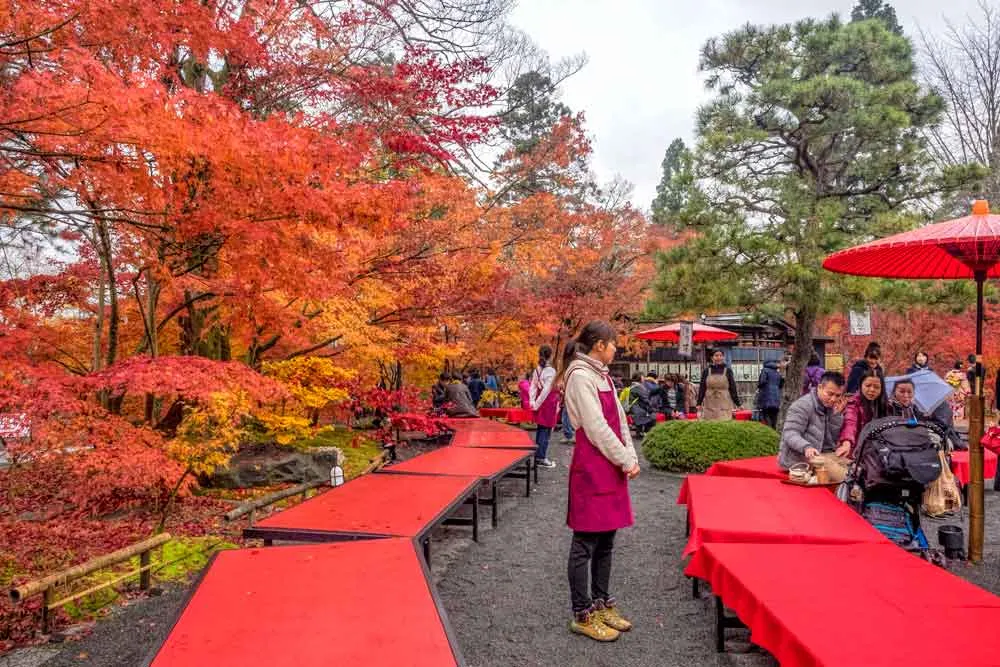
The one above is at Eikan-do on the Philosophers Path in east Kyoto. The weather was cool but it was the peak day of the leaves at this temple so the opportunity to warm up with a steaming cup of sencha and a plate of warm glazed Dango was very welcome.
27. Put on your walking shoes and immerse yourself in the city
We find Japan as a whole is best explored on foot, we’ll take a train, bus or subway somewhere hop off then just wander around through the side streets and parks, into restaurants, galleries, attractions or shops as they take our interest for the rest of the day. Kyoto is perfect for this and while it is a city and you might want to dress up a little, I strongly suggest you choose a pair of comfortable and familiar walking shoes.
If you are starting in Kyoto city you can begin almost anywhere are discover the culture, history, great food and fabulous sites heading in almost any direction but we’ve put together a few suggestions you might enjoy. Our self-guided central Kyoto walking tour article has a map and plenty of suggestions including a castle, the palace gardens, temples, shrines, and traditional arts including kimono weaving and flower arranging. There are also ideas for where to eat along the way. Our eastern Kyoto walking guide also includes a map and will take you all the way from Kyoto station to Ginkakuji if you have the time and energy but individual sections along the way are also a good choice.
28. Step back in time on Shirakawa-Dori
This might be one of the most pretty areas of the city and while it will be full of people at the peak of cherry blossom, at other times, especially early in the morning, or wandering through on your way to dinner it can be almost deserted and give you a sense of what the tea houses and okiya used by geisha, might have felt like back in their heyday with the canals, cobbles and heritage wooden buildings.
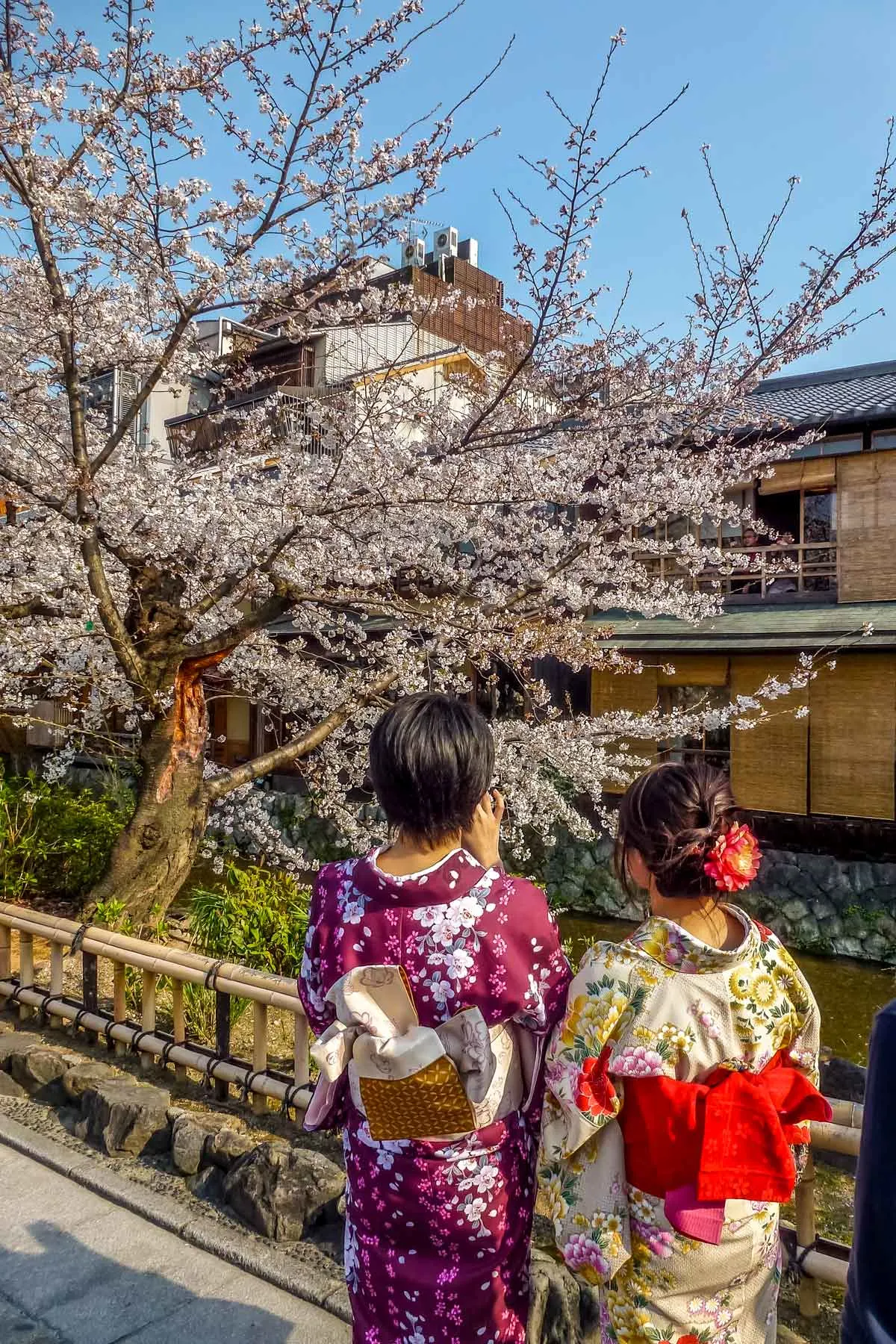
29. Head out to a seasonal light up event
Kyoto has a number of seasonal light up events during the year at different venues. These are generally at popular tourist sites that open into the evening with lanterns or light installations that give a unique opportunity to visit the attraction after dark and get a different perspective.
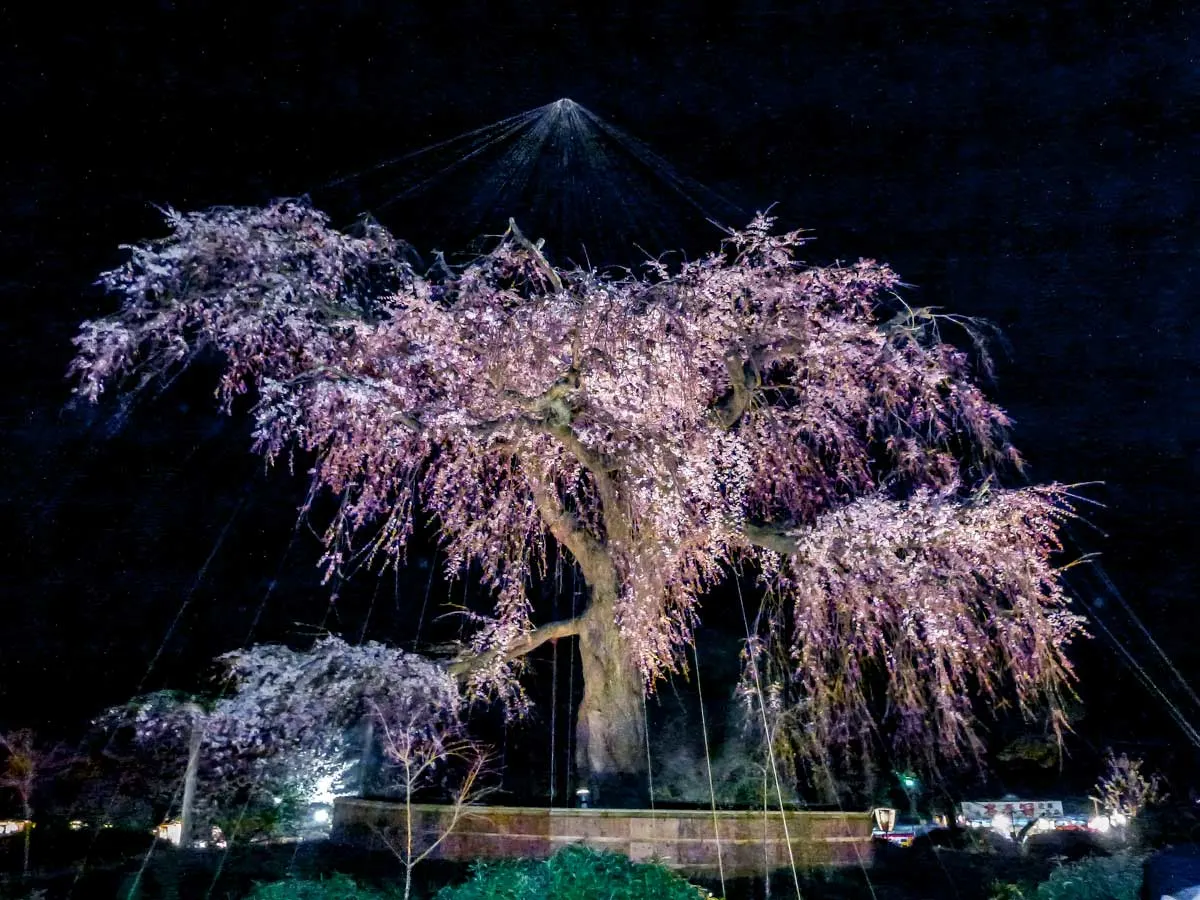
Some you may want to build into your calendar if you are in town are:
- Hanatoro is held from early to mid-March when the streets of Higashiyama are lit by lanterns along a 5 km path. The walk takes in Kiyomizudera, the Yasaka Pagoda, the heritage back streets and many spots through Gion. In addition to traditional lantern styles, there are spotlights and art installations.
- At various times during the year temples such as Kodai-ji Temple and Hokan-Ji Temple will have seasonal light-ups, these are common during the cherry blossoms, to tie into Hanatoro and for the autumn leaves.
- Nijo castle is another popular one during cherry blossom as it is one of the city’s favourite sites for viewing so walking through the lit grounds offers an alternative view of the iconic blooms. In the last couple of years, a light show projection on the castle walls has added even more drama.
30. View the city from above
There are a few spots around to view the city from above and because Kyoto is mostly low-rise buildings, despite being a large sprawling city you don’t need to get up as high above it as you do in many other places.
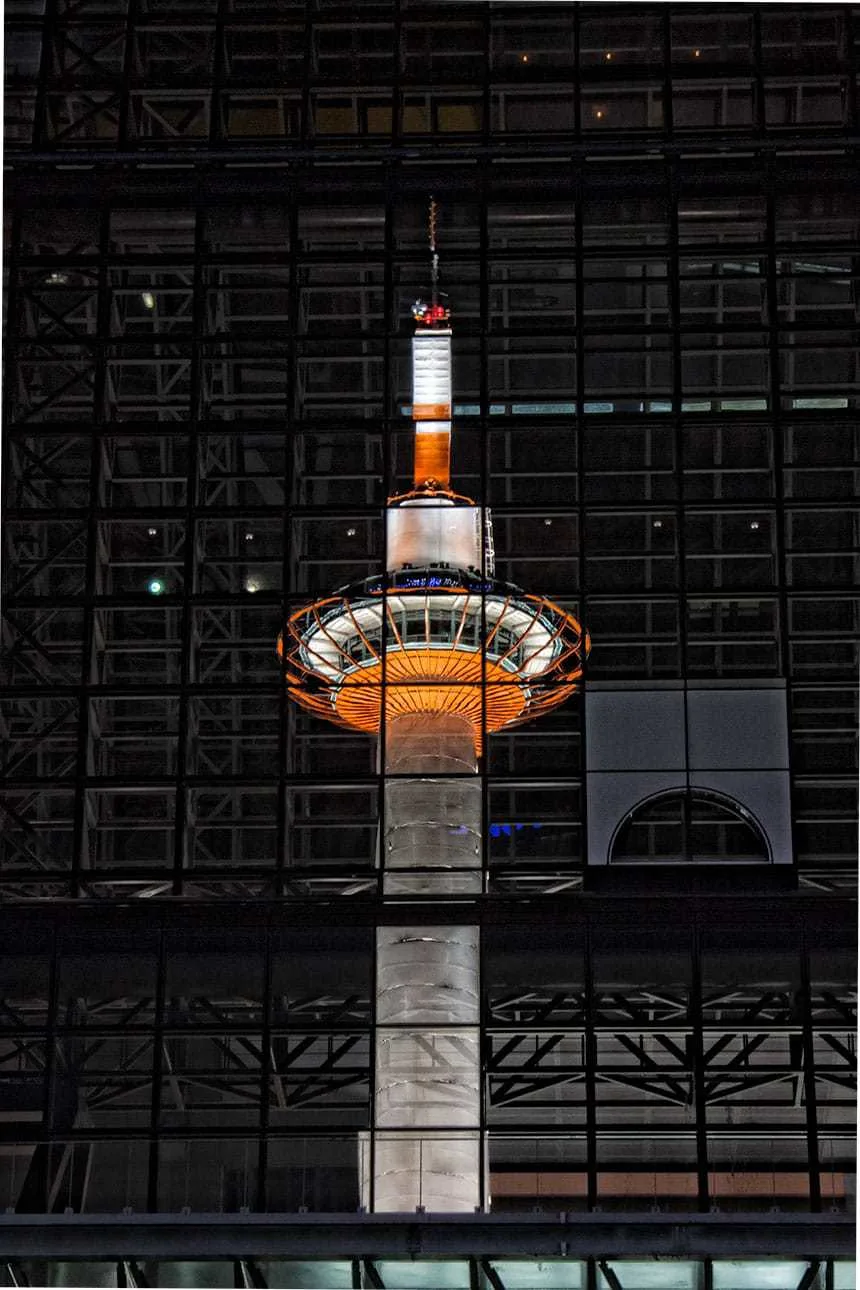
The first place you would probably think of is Kyoto Tower which you will probably have noticed glowing above you if you return to Kyoto Station at night. Within the outer Kyoto station building itself, there is also a viewing deck at the top and an enclosed skywalk with views.
While out and about exploring the are other options we enjoy the city views from. One is the top of the hill after climbing up through all the tori at Fushimi Inari, another is from the entrance of Kiyomizudera temple looking back to the city and a third is looking south from the hillside behind Ginkakuji temple.
When to visit Kyoto
I would argue that there’s no bad time to visit Kyoto but the city lends itself to celebrating the seasons. The sakura (cherry blossom) in spring is beautiful, the temples, gardens and even the city streets are lined with soft pink blossoms. The autumn leaves (Koyo) are another stunning time, those same deciduous cherry trees plus a huge number of maples and other ornamentals planted in gardens, parks and growing up the surrounding mountains all create a spectacle of jewel tones around the city.
Both spring and fall are seasons of celebration in a city that has retained its tight ties with its culture and history. From the spring dance shows put on by the various geisha districts to the seasonally specific menus the time of year is important and Japan and never more so than in Kyoto.
We’ve visited Kyoto in winter too and it has its own appeal. Snow falls occasionally in Kyoto but rarely stays on the ground, if you are lucky enough to experience that be sure you have your priority list of places to visit because it won’t last long. Temples and shrines are particularly dramatic and photogenic dusted in snow, my personal choices if I’m lucky enough to see it would be the Golden Pavillion, the temple itself and the historic shopping street at Kiyomizudera or some of the smaller temples up the hill in Arashiyama.
Summer in Japan is hot and humid. Air conditioning isn’t common and you’ll likely be walking quite a bit. The attraction of summertime is that gardens and natural areas are lush green and the flowers are blooming. It’s also the season of fireworks and festivals.
Where to stay in Kyoto
Accommodation can be reasonably expensive in Kyoto so it’s worth doing your research and booking early to get the best deals especially if you plan to be there during peak travel times such as the cherry blossom season or Golden Week. Japanese accommodation is well known for being compact but it does depend on where you stay just how small that is. Generally, apartments and hotel rooms make good use of space and have smart storage options.
Think about what your priorities are and pick a location and style based on those. If you plan on doing a number of day trips out of the city you may want to be near the train station. Do you plan to cook your own food or eat out each day? Are you happy to walk a good distance each day and wander around the city in the evening or do you want a range of restaurants at your door?
We’ve used both hotel and apartment accommodation and each has advantages. A hotel we love and find particularly convenient is the Hotel Granvia Kyoto which is part of the huge Kyoto Station complex. From Australia the direct flights we use generally arrive late in the evening meaning you catch one of the last airport trains out to Kyoto so it’s nice to just wheel your bags through the station and check into your room. It’s a higher-end hotel, good sized rooms, well-appointed, impeccably clean and friendly but it comes at a price.
Another option we have used a few times is the self-contained Citidines Kyoto apartments. They are modern and comfortable, give you the option of making simple meals and doing laundry if you wish and are conveniently located just one subway stop from Kyoto Station. We usually walk to the station, city and other attractions from the apartment but the subway right outside the door is another convenient option.
Recently we stayed at Gozan Hotel and Serviced Apartments in central Kyoto. This is a fabulous location an easy walk to the attractions of the Higashiyama area, the canal, restaurants and the subway/train station. I loved the clean modern room with traditional styling and touches, there is also a small kitchenette and laundry facilities in the room.
I thought it was good value and would pick to stay there again for the location and styling, the room was gorgeous with lovely touches of Japan but Drew was a little frustrated at the lack of drawer and wardrobe space to unpack into, something I hope they will address.
Getting Around Kyoto
On foot
Don’t discount walking as a means of transport in Japan and especially in Kyoto. The city is flat and safe to walk around, even in the evening. This is absolutely the best way to get around in our view giving the opportunity to discover something new every few steps. If you are looking for some inspiration to get you started, take a look at our articles on:
- Walking Kyoto: A series covering walking the attractions of eastern Kyoto. Walk the guided route through the beautiful and historic Higashiyama district or select sections that appeal to your interests and complete only a portion at a time.
- A self-guided walking tour through central Kyoto taking in the Imperial Palace, Nijo Castle, a historic food market, temples & shrines and a couple of traditional geisha districts.
By subway
My second choice for getting around would be the subway because it’s so clean, fast, efficient and simple. Kyoto’s subway system is more limited than in larger cities like Tokyo and Osaka. It’s comprised of two lines, the Karasuma line goes north-south and the Tozai line goes east-west. They are designed around the commuter flows rather than the city’s attractions so while there are a lot of places you can get to by subway there are others where it’s not possible.
By Bus
Local buses are my least favourite way to get around in Kyoto but for some places that you are likely to want to go, it’s that or a taxi. Buses are very clean but they are slow and stop often. Seats are small if you aren’t of an average Japanese build you may not find it a very comfortable trip.
By Train
Trains are useful to get to the outer areas and the suburbs of Kyoto. It’s the best way to get to Fushimi Inari or Arashiyama for example and we find it useful for the northern part of Kyoto city.
Using Kyoto as your base city to explore further afield
Kyoto is an excellent city base for exploring other towns and cities nearby. Packing up, moving luggage around and checking in and out too often can waste time that could otherwise be spent exploring. If your time is limited and doesn’t allow for stays in multiple cities there are many options you can consider as a day trip from Kyoto city.
The convenience of multiple company train lines, buses, the subway and bullet trains all stopping at Kyoto station gives plenty of choices. Shorter trips include Osaka, Nara, Nagoya and Uji but Kobe, Okayama, Hikone, Kanazawa, Hiroshima and Takayama are also possible.
We have a lot of information on how to get to each place along with detailed suggestions of what to see and do in a day while you are there in our article 16 of the best day trips from Kyoto. We’ve taken these trips ourselves, many of them multiple times over the years so they are genuinely all possible and enjoyable within a single day using public transport.
Tips for travel in Kyoto
✈ For all the essential tips to help plan your visit to Japan see our comprehensive and FREE Japan guide.
✈ Free WIFI isn’t widely available in Japan. For translation, directions, timetables and other information on the go personal WIFI is one of our essentials. We look at the options in our cheat sheet to stay connected in Japan. We use WIFI2Go from Australia (mention 2 Aussie Travellers for a discount) or airport collection in Japan.
✈ You don’t need a JR pass if you are only visiting Kyoto but if you’re travelling distance by train it can be a bargain. See if the JR pass suits your trip and check prices with our preferred supplier.
✈ Looking for a great place to stay in Kyoto? We use and trust Booking.com for its great selection and independent reviews. We also like that many properties are cancellable if necessary and that we don’t pay until we arrive.
If you’ve been to Kyoto recently and think we missed something feel free to drop a comment below. If you’re planning to visit and still have a few questions let us know and we’ll get back to you.
If you found this article useful please consider saving it to Pinterest. It makes it easy for you to find it again, it helps us, and it helps other travellers to find the information they are looking for.
